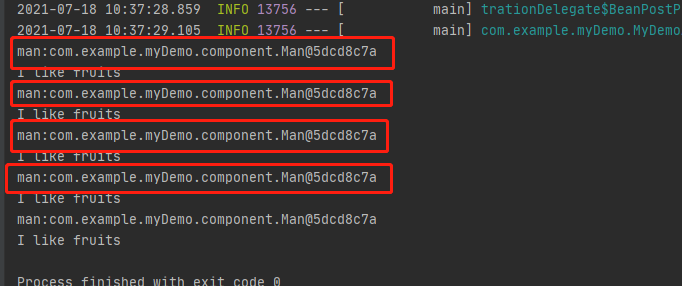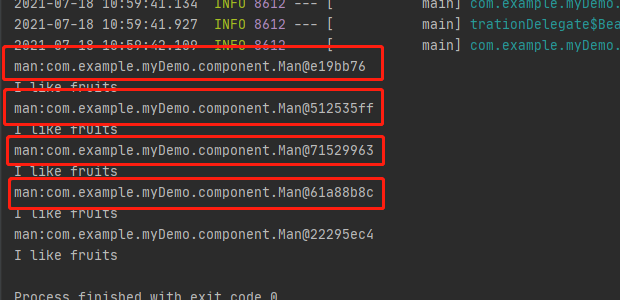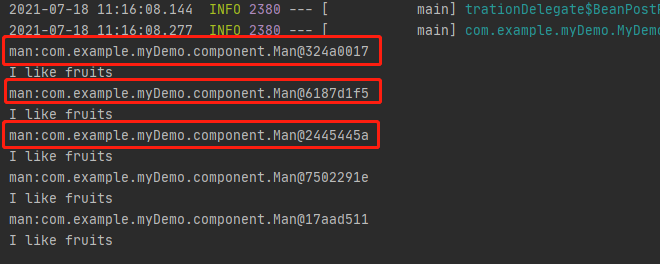您好,登錄后才能下訂單哦!
您好,登錄后才能下訂單哦!
這篇文章主要介紹“spring中怎么向一個單例bean中注入非單例bean”,在日常操作中,相信很多人在spring中怎么向一個單例bean中注入非單例bean問題上存在疑惑,小編查閱了各式資料,整理出簡單好用的操作方法,希望對大家解答”spring中怎么向一個單例bean中注入非單例bean”的疑惑有所幫助!接下來,請跟著小編一起來學習吧!
前言
錯誤實例演示
實現ApplicationContextAware接口
lookup method
lookup method簽名
看到這個題目相信很多小伙伴都是懵懵的,平時我們的做法大都是下面的操作
@Component
public class People{
@Autowired
private Man man;
}這里如果Man是單例的,這種寫法是沒有問題的,但如果Man是原型的,這樣是否會存在問題。
這里有一個原型(生命周期為prototype)的類
package com.example.myDemo.component;
import org.springframework.context.annotation.Scope;
import org.springframework.stereotype.Component;
@Component
@Scope(value = "prototype")
public class Man {
public void eat() {
System.out.println("I like beef");
}
}有一個單例(生命周期為singleton)的類
package com.example.myDemo.component;
import org.springframework.beans.factory.annotation.Autowired;
import org.springframework.beans.factory.annotation.Lookup;
import org.springframework.stereotype.Component;
@Component
public class Woman {
//使用依賴注入的方式,注入原型的Man @Autowired
private Man man;
public void eat() {
System.out.println("man:"+man);
System.out.println("I like fruits");
}
}下面看測試方法,
package com.example.myDemo;
import com.example.myDemo.component.MyFactoryBean;
import com.example.myDemo.component.Woman;
import com.example.myDemo.po.Student;
import org.springframework.boot.SpringApplication;
import org.springframework.boot.autoconfigure.SpringBootApplication;
import org.springframework.boot.autoconfigure.jdbc.DataSourceAutoConfiguration;
import org.springframework.boot.autoconfigure.orm.jpa.HibernateJpaAutoConfiguration;
import org.springframework.context.ApplicationContext;
@SpringBootApplication(exclude={DataSourceAutoConfiguration.class, HibernateJpaAutoConfiguration.class})
public class MyDemoApplication {
public static void main(String[] args) {
ApplicationContext ac=SpringApplication.run(MyDemoApplication.class, args);
Woman woman=(Woman)ac.getBean("woman");
for(int i=0;i<5;i++){
woman.eat();
}
}
}看下測試結果,

上面的結果顯示Woman中的man是單例的,因為5次循環打印打出的結果是同一個對象,發生了什么,
Woman是單例的,Man是原型的,我們使用常規的@Autowired注解注入的卻是同一個實例,這里想下為什么Man是一個對象,Woman是單例的,意味著在整個spring容器中只有一個實例,在屬性注入的時候肯定也只會注入一次,所以其中Man屬性也只能是一個實例,出現上圖的結果也就不稀奇了。
現在有這樣一個需求要向單例bean中注入原型bean,要怎么實現這樣的需求
都知道ApplicationContextAware接口是spring提供的一個擴展點,實現該接口的類可以獲得ApplicationContext
Woamn類改成下面的樣子
package com.example.myDemo.component;
import org.springframework.beans.BeansException;
import org.springframework.beans.factory.annotation.Autowired;
import org.springframework.beans.factory.annotation.Lookup;
import org.springframework.context.ApplicationContext;
import org.springframework.context.ApplicationContextAware;
import org.springframework.stereotype.Component;
@Component
public class Woman implements ApplicationContextAware {
private Man man;
private ApplicationContext ac;
public void eat() {
this.man = (Man) ac.getBean("man");
System.out.println("man:" + man);
System.out.println("I like fruits");
}
@Override
public void setApplicationContext(ApplicationContext applicationContext) throws BeansException {
this.ac = applicationContext;
}
}Woman實現了ApplicationContextAware接口,注入了ApplicaitonContext對象,然后再eat()方法中通過AppicationContext獲得Man的實例,看測試結果,

可以看到man屬性是多例的也就是符合原型模式的定義。
思考下為什么采用這種方式可以達到注入原型bean的目的
在eat()方法中使用ApplicationContext的getBean方法獲取Man,eat()方法每執行一次均會調用一次getBean方法,getbean方法在執行的時候的時候會判斷Man的生命周期,如果是原型(prototype)的,那么每調用一次就會重新實例化一個Man,所以會出現上述的結果。
該方法有一個很大的缺點那就是和spring耦合度太高,不符合降低系統的耦合度的要求。
spring也考慮了向一個單例bean中注入原型bean的情況,提供了@Lookup注解,在XML配置方式下是<lookup-method>標簽,這里僅使用注解的方式演示,
Woman類修改如下,
package com.example.myDemo.component;
import org.springframework.beans.BeansException;
import org.springframework.beans.factory.annotation.Autowired;
import org.springframework.beans.factory.annotation.Lookup;
import org.springframework.context.ApplicationContext;
import org.springframework.context.ApplicationContextAware;
import org.springframework.stereotype.Component;
@Component
public class Woman {
private Man man;
public void eat() {
this.man = createMan();
System.out.println("man:" + man);
System.out.println("I like fruits");
}
@Lookup
public Man createMan(){
return null;
}
}看下測試結果,

上圖顯示man是一個多例的,也就是向單例bean中注入了原型bean,其作用的是@Lookup注解。
通過@Lookup注解便完成了注入原型bean的目的,留個思考問題spring是如何做到的?
被@Lookup注解或<lookup-method>配置的方法有如下要求,
public|protected [abstract] return-type methodName(no-argments)
方法可以是public也可以是protected;
方法可以是抽象的也可以是非抽象的;
方法的返回值是要注入的類型,這里是prototype類型的類;
方法沒有入參;
方法體可以是空的。具體返回值可以是null或任何類型,對結果沒有影響;
到此,關于“spring中怎么向一個單例bean中注入非單例bean”的學習就結束了,希望能夠解決大家的疑惑。理論與實踐的搭配能更好的幫助大家學習,快去試試吧!若想繼續學習更多相關知識,請繼續關注億速云網站,小編會繼續努力為大家帶來更多實用的文章!
免責聲明:本站發布的內容(圖片、視頻和文字)以原創、轉載和分享為主,文章觀點不代表本網站立場,如果涉及侵權請聯系站長郵箱:is@yisu.com進行舉報,并提供相關證據,一經查實,將立刻刪除涉嫌侵權內容。